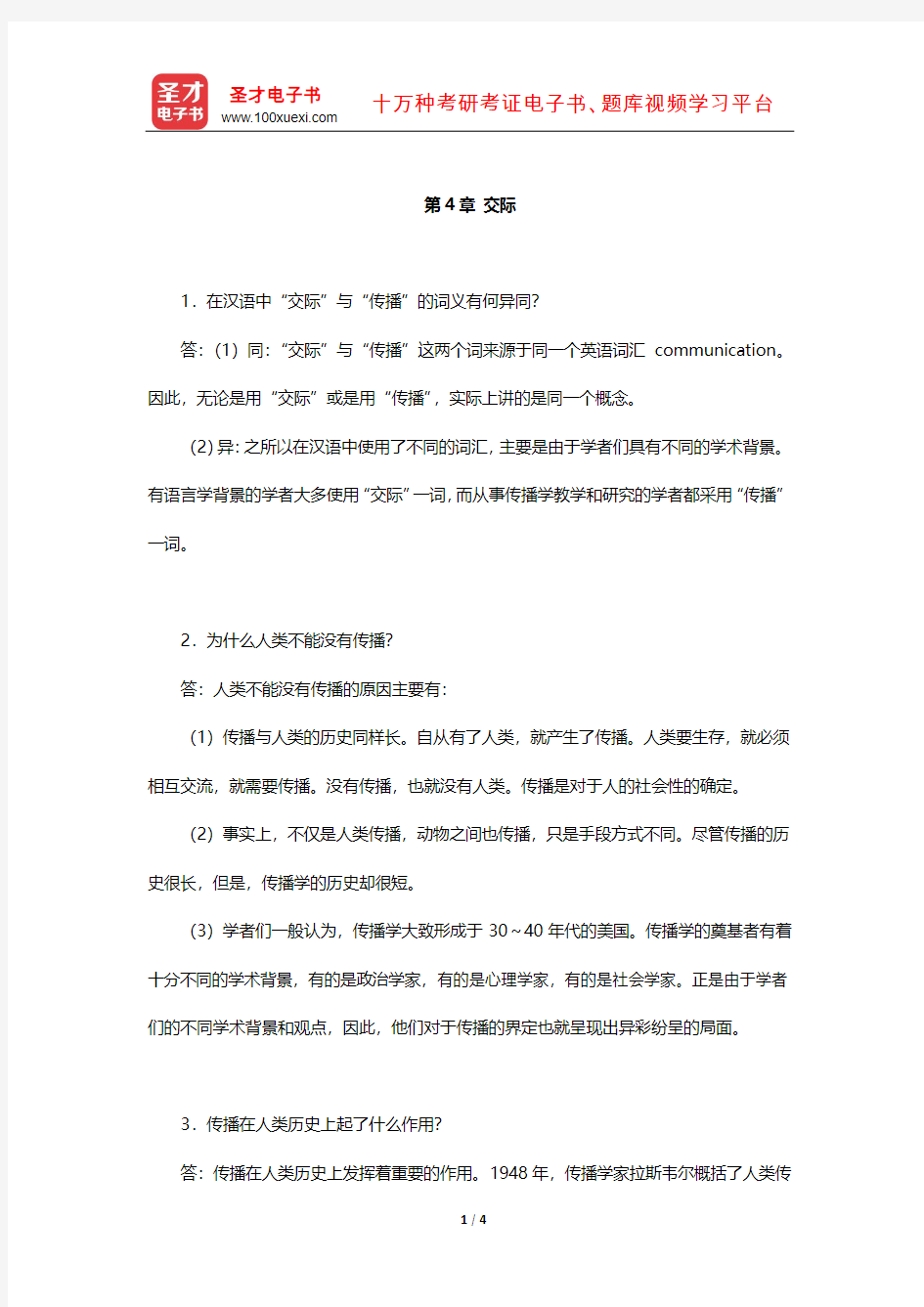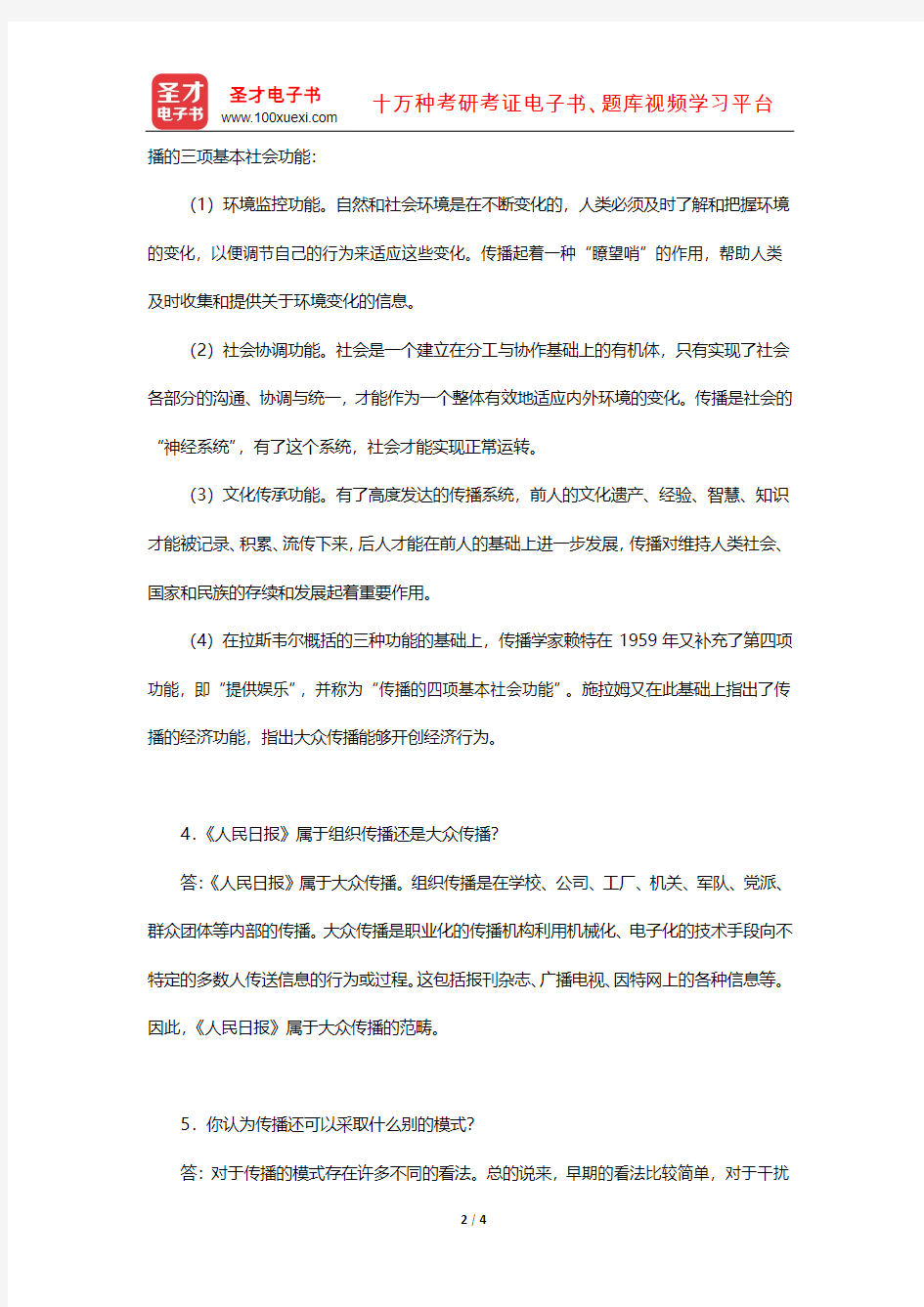

第4章交际
1.在汉语中“交际”与“传播”的词义有何异同?
答:(1)同:“交际”与“传播”这两个词来源于同一个英语词汇communication。因此,无论是用“交际”或是用“传播”,实际上讲的是同一个概念。
(2)异:之所以在汉语中使用了不同的词汇,主要是由于学者们具有不同的学术背景。有语言学背景的学者大多使用“交际”一词,而从事传播学教学和研究的学者都采用“传播”一词。
2.为什么人类不能没有传播?
答:人类不能没有传播的原因主要有:
(1)传播与人类的历史同样长。自从有了人类,就产生了传播。人类要生存,就必须相互交流,就需要传播。没有传播,也就没有人类。传播是对于人的社会性的确定。
(2)事实上,不仅是人类传播,动物之间也传播,只是手段方式不同。尽管传播的历史很长,但是,传播学的历史却很短。
(3)学者们一般认为,传播学大致形成于30~40年代的美国。传播学的奠基者有着十分不同的学术背景,有的是政治学家,有的是心理学家,有的是社会学家。正是由于学者们的不同学术背景和观点,因此,他们对于传播的界定也就呈现出异彩纷呈的局面。
3.传播在人类历史上起了什么作用?
答:传播在人类历史上发挥着重要的作用。1948年,传播学家拉斯韦尔概括了人类传
播的三项基本社会功能:
(1)环境监控功能。自然和社会环境是在不断变化的,人类必须及时了解和把握环境的变化,以便调节自己的行为来适应这些变化。传播起着一种“瞭望哨”的作用,帮助人类及时收集和提供关于环境变化的信息。
(2)社会协调功能。社会是一个建立在分工与协作基础上的有机体,只有实现了社会各部分的沟通、协调与统一,才能作为一个整体有效地适应内外环境的变化。传播是社会的“神经系统”,有了这个系统,社会才能实现正常运转。
(3)文化传承功能。有了高度发达的传播系统,前人的文化遗产、经验、智慧、知识才能被记录、积累、流传下来,后人才能在前人的基础上进一步发展,传播对维持人类社会、国家和民族的存续和发展起着重要作用。
(4)在拉斯韦尔概括的三种功能的基础上,传播学家赖特在1959年又补充了第四项功能,即“提供娱乐”,并称为“传播的四项基本社会功能”。施拉姆又在此基础上指出了传播的经济功能,指出大众传播能够开创经济行为。
4.《人民日报》属于组织传播还是大众传播?
答:《人民日报》属于大众传播。组织传播是在学校、公司、工厂、机关、军队、党派、群众团体等内部的传播。大众传播是职业化的传播机构利用机械化、电子化的技术手段向不特定的多数人传送信息的行为或过程。这包括报刊杂志、广播电视、因特网上的各种信息等。因此,《人民日报》属于大众传播的范畴。
5.你认为传播还可以采取什么别的模式?
答:对于传播的模式存在许多不同的看法。总的说来,早期的看法比较简单,对于干扰
因素、反馈以及社会环境等考虑较少,而后期人们的认识越来越深入,对于传播模式不断作出修正,更准确地反映传播的真实情况。
(1)早期影响最大的传播模式是Harold Lasswell提出的。他的模式通常被称作5W 模式,即:Who(谁);says What(说什么);in What channel(通过什么渠道);to Whom (对谁);with What effects(得到什么效果)。这个模式的特点在于它的简明扼要,把传播的过程清清楚楚的表现出来,对于传播学需要研究的几个主要环节都明确地指出,据此人们可以进行传者研究、内容研究、媒介分析、受者研究以及效果研究等。
(2)1949年,Claude Shannon和Warren Weaver共同提出了另一个线性模式,他们的模式把媒介作了分解,同时增加了另一个要素:信号以及干扰因素:噪音。这一模式对于传播的过程虽然比5W模式有了更细致的分析,考虑也更周到,但是它并未根本解决线性模式的缺陷。
(3)在50年代,Charles Osgood和Wilbur Schramm提出循环式的模式,把反馈这一重要概念加入到传播过程中。
(4)之后,社会学家Jack Lyle和M·Lyle把传播过程看作是社会过程之一,把传播置于总的社会环境中考察,从而涵盖了传播的外部结构。
6.了解传播模式对于人们分析跨文化交际有什么帮助?
答:研究传播模式对于人们深入了解跨文化交际有重大的意义。
(1)从传播的过程人们可以看出编码和译码是两个最容易出问题的环节
即使在具有相同的语言和文化背景的人们之间进行交际也可能出现编码与译码不一致的情况。在不同文化背景的人们进行交际时自然更可能出现误解。比如美国人表示友好这一讯息时可以说:“We must get together soon.”并没有邀请对方吃饭的意思。也就是说,
他编码时使用的符号并没有邀请的含义。但是,一个不了解美国文化的中国人在译码时却常常会得出邀请的讯息。
(2)Lyle的传播模式的特点是把传播放在社会环境中考察
无论是传者或是受者都受到周围群体的影响,同时,所有的传播都不能脱离大的社会环境。这对于人们了解跨文化交际的过程有很大的启发。人们观察人们的跨文化交际过程,不能孤立地看,而是要考虑到传者和受者的周围的群体以及整个的社会环境。
跨文化交际习题
跨文化交际习题 1. 单选题:(1.0分) 在日本,喝汤时发出很大吮吸的声音会被认为是______。 A. 粗鲁而讨厌的 B. 你喜欢这种汤的表现 C. 在家里不要紧,在公共场合则不妥 D. 只有外国人才这么做 解答: B 参考答案: B 2. 单选题:(1.0分)
在日本,自动售货机里出售除下列哪一种饮料以外的所有其他饮料? A. 啤酒 B. 加糖精的保健饮料 C. 加糖的咖啡 D. 美国公司生产的软饮料 解答: B 参考答案: B 3. 单选题:(1.0分) 在拉丁美洲,管理者______。 A. 一般会雇佣自己家族的成员 B. 认为雇佣中级家族成员是不合适的 C. 强调雇佣少数特殊群体员工的重要性
D. 通常雇佣比实际工作所需更多的员工 解答: A 参考答案: A 4. 单选题:(1.0分) 在拉丁美洲,人们______。 A. 认为交谈时和对方进行眼神交流是不礼貌的 B. 总是等到对方说完才开始说话 C. 身体接触次数比相似情况下北美商人多 D. 避免身体接触,因为这被认为是对个人隐私的侵犯解答: C 参考答案: C
5. 单选题:(1.0分) 马来西亚的主要宗教是______。 A. 佛教 B. 犹太教 C. 基督教 D. 伊斯兰教 解答: D 参考答案: D 6. 单选题:(1.0分) 在泰国______。 A. 男性之间挽手同行很常见
B. 男女之间在公共场合挽手很常见 C. 男女同行是很粗鲁的举止 D. 传统上男性和女性在街上遇见会互相亲吻解答: A 参考答案: A 7. 单选题:(1.0分) 在印度,进食时恰当的举止是______。 A. 用右手取食物,用左手吃 B. 用左手取食物,用右手吃 C. 取食物和吃都只用左手 D. 取食物和吃都只用右手 解答: D 参考答案: D
精品文档 Culture: Culture is the total accumulation of beliefs, customs, values, behaviors, down and passed are shared, learned institutions and communication patterns that through the generations in an identifiable group of people. law, food, etiquette, religion, literature, language, Objective Culture: history, and customs. are and how they feelings and attitudes about how things Subjective Culture: communication family, spaces, friendship, love, concept should be –the of time, pattern, etc. Learned, transmitted from generation to generation, based on : Characteristics symbols, dynamic, ethnocentric. It is meant to be a contrast to learning “about”culture underscores Doing Culture: of meaning, process of making communicating across cultures is a the idea that build another, know one so they can get to another people understanding one relationships, and solve problems together. It should not be words on paper, but ideas in practice. individuals which process through Communication: Human communication is the respond to and create messages ––in relationships, groups, organizations and societies to adapt to the environment and one another. Dynamic and interactive Characteristics:interaction between : Communication Generally speaking, it refers to Intercultural people from different cultural backgrounds, such as interactions between people from Hispanic and whites and African Americans, between America and China, between Japanese Americans The form of Intercultural Communication people from different races a. Interracial communication – different but of the same race Interethnic communications –the parties are of b. ethnic origins. same the between members of c. Intercultural communication –communication multiple or hold dual or both of the participants one culture, in which )(gay, disabled, Mexican American, African American, or https://www.doczj.com/doc/3f18266818.html,munication Competence (ICC competence) how much one know about communication. The cognitive component –The affective component –one's motivation to
最新英语专业全英原创毕业论文,都是近期写作 1委婉语的跨文化交流及其语用功能 2法律英语词汇的特点及其翻译 3论奥斯丁女性主义观点在《爱玛》中的体现 4建构主义学习理论在中学英语教学中的应用 5《宠儿》中塞丝的性格特征分析 6《榆树下的欲望》之农场意象--基于生态女性主义的分析 7从语境视角浅析《生活大爆炸》中反语的幽默属性 8文档所公布各专业原创毕业论文。原创Q 95 80 35 640 9浅谈英语复杂句的翻译 10劳伦斯小说中的女性形象 11孤独的精神探索者——《月亮和六便士》和《刀锋》中主人公形象分析 12基于语料库对红楼梦两个英文版本中红色的翻译研究 13Error Analysis on English Writing by Senior High School Students 14跨文化交际中的语用失误与避免方法 15中美企业并购中的文化整合分析 16盖茨比的人物形象分析 17政论文英译的翻译策略研究 18An Analysis of Two Main Characters in Moby Dick 19浅谈儿童文学在儿童成长中的作用-弗朗西斯霍奇森伯内特《小公主》和《秘密花园》之比较 20浅析英文电影在高中英语教学应用 21从认知语言学角度浅析网络语言中的隐喻现象 22大学英语课堂教学师生互动建构浅析 23从功能翻译理论看中国饮食文化负载词的翻译策略 24 25从《远离尘嚣》看托马斯哈代的生态自然观 26从《京华烟云》探析林语堂的女性观 27论《威尼斯商人》中的宗教思想影响 28爱默生的超验主义和老子的道家思想对比 29论《吉姆老爷》中的英雄主义 30 A Comparison of the English Color Terms 31论中西文化中家庭观念的差异 32论中美日常交际的文化差异 33影响大学生英语自主学习的因素研究 34On the Translation of English Impersonal Sentences 35试析海明威《丧钟为谁而鸣》中的人物形象 36论流行网络词汇的汉英翻译 37 A Comparative Study of English and Chinese Taboos in the Context of Intercultural Communication 38 A Comparison of the English Color Terms 39从《远离尘嚣》和《无名的裘德》看托马斯?哈代的婚恋观 40中美两国家庭教育理念的比较
第一讲跨文化交际 1. 在你的日常活动中哪些是比较典型的跨文化交际? 答:(1)具有不同文化背景的人从事交际的过程就是跨文化交际。 (2)日常活动中比较典型的跨文化交际有: ①中外领导人谈判、进出口公司的工作人员与外国商人谈生意; ②和外国旅游者、外国留学生、外国教师交往; ③阅读外国小说、观看外国电影、电视节目。 2. 你认为强调个人之间的文化差异有什么利弊? 答:强调个人之间的文化差异有如下利弊: (1)利:每个人都隶属于若干群体,而且没有哪两个人隶属的群体是完全相同的。即使在同一群体中,每个人的态度、价值和信念也不会完全一样。因此,每个人都应该被认为是独特的。强调个人的差异,就是在从地区、职业、年龄、性别等方面来研究不同文化对个体的影响,这有助于跨文化交际深入开展。 (2)弊:过于强调个人之间的文化差异也有一定的弊端。个体只是一种或多种文化的具体情况。根据传统的观念,文化通常不是指个人行为,而是指一个群体的生活方式和习惯,个人之间的差异研究只有在把他们当作群体代表时才有意义。过于强调个人文化之间的差异会使跨文化交际变得非常繁琐,实际上取消了跨文化研究的意义。 3. 我国的地区文化差异是否可以作为跨文化交际研究的重要方面? 答:我国的地区文化差异可以作为跨文化交际研究的重要方面。 (1)跨文化交际研究的重要性排序如下:主流文化—亚文化—地区文化—小群体文化。 (2)地区文化的差异是跨文化交际研究的重要课题之一。我国幅员辽阔、地域广袤,地势高低起伏,地形复杂多变,由于空间分布差异,各地区形成了具有各自地方特斯的区域文化。 (3)同时,我国是一个多民族国家,每个民族都有自己的民族文化传统,这些也构成了地区文化的一部分。这些地区文化从总体上看,特点显著,区别性强,差异性大,值得进行跨文化研究。
跨文化交际学概论笔记 第一章跨文化交际 一、什么是跨文化交际——具有不同文化背景的人从事交际的过程跨文化交际之所以在今天日益引起人们的注意,主要原因是由于交通工具的进步与通讯手段的发展,使得不同国家、不同种族、不同民族的人能够频繁地接触和交往。L.S.Harms 认为,在世界范围内的交际经历了五个阶段:语言的产生;文字的使用;印刷技术的发明;近百年交通工具的进步和通讯手段的迅速发展;跨文化交际。近二十年来的交际是以跨文化为特征的。 二、第二章跨文化交际学 跨文化交际学在美国Intercultural Communication (与人类学、心理学、传播学关系密切) 1.首先在美国兴起。美国有来自各个国家的移民,有各自的文化系统和风俗习惯,逐渐在美国社会形成了多元文化的格局;美国与各国交往频繁。 2.Edwar Hall 《无声的语言》跨文化交际学的奠基之作。认为不同文化背景的人们在使用时间、空间表达意义方面表现出明显的差异。(对时间、空间、交际的关系作了深入探讨) 3.1970 年是具有重要意义的一年在这一年,国际传播学会承认跨文化交际学是传播学的一个分支,成立了跨文化交际学分会。1972 年,第一届跨文化交际学国际会议,日本东京。 第四章交际 一、交际与传播 这两词来源于同一英语communication表示的是同一个概念,不同学科背景的人采用不同术语。有语言学背景的学者大多使用“交际”,从事传播学教学和研究的学者都采用“传播”。 三、传播的种类 传播可分为人类传播和非人类传播;人类传播又可分为社会传播和非社会传播。非社会传播指内向传播(自我传播),社会传播包括人际传播,组织传播,大众传播。 内向传播(intarpersonal communication)只一个人自己脑子里在自我交流活动或是自言自语 人际传播(interpersonal communication)两个人或以上的信息传受过程。如交谈,书信,小组讨论,大会演讲等。 组织传播(organizational communication)在学校,公司,工厂,机关,军队,党派,群众团体等内部的传播,不都是自上而下的,可具有不同模式,纵式或横式,要注意因文化差异造成的传播不通的局面。 大众传播(mass communication)职业化的传播机构利用机械化,电子化的技术手段向不特定的多数人传送信息的行为或过程,如报刊杂志,广播电视,因特网信息等。 第四章语言交际 一、语言与文化密不可分 (语言反映一个民族的文化,同时有受到文化的巨大影响。)语言与文化有着密切的关系。由于语言的产生和发展,人类文化才得以产生和传承。不存在没有语言的文化,也不存在没有文化的语言。广义的文化包括语言,同时文化又无时无刻不在影响语言,使语言为了适应文化发展变化的需要而变得更加精确和缜密。语言既是文化的载体,又是文化的写照。 E.g.①亲属称谓是语言反映文化的一个突出例证。汉族不仅注重长幼顺序,而且对于是父系、母系或婚系亦十分重视。古人有强烈的传宗接代的观念,按血缘远近区别亲疏,家族里又有内外嫡庶之别。——后来亲属称谓的简化,意味着家族关系在社会生活中不占那么重要的地位。在我国个别地区的亲属称谓中,只有男性称谓,没有女性称谓,可能是古代父系社会的
The Major Features of Intercultural Communication Communication is the process of understanding and sharing meaning. It occurs whenever information is exchanged between a sender and a receiver. Sending signals of one kind or another is inevitable. And the process of sending and receiving message is complex. What a signal means to the sender is not always what it means to the receiver. Therefore, the trick is to transmit appropriate information to appropriate receivers at appropriate times. Communication is a symbolic behavior. And the most important mode of communication is verbal. Language is a highly developed symbolic system of human communication. As a most basic element of culture, language is the means, by which culture is transmitted from generation to generation and a person’s language greatly influences how he or she perceives the world. The major features of communication inclouds: https://www.doczj.com/doc/3f18266818.html,munication is symbolic Human communication is symbolic. We employ symbols as a way of sharing our internal states. The ability to produce and use symbols enables human beings to share their internal status and infer what another human being is experiencing, thus distinguishing human beings with other animals. Symbols are at the core of communication, but no symbol means the same thing to everyone, because different cultures often employ different symbols and usually assign special meaning to them. For example, dragon has been taken as totem by Chinese for thousands of years, it represents a kind of powerful and propitious animal, although it may never really exist. However, in western cultures, dragon is a kind of fierce and evil animal. Therefore, many people insist that we should not translate “龙” into “dragon”, since the two symbols represents totally different things. https://www.doczj.com/doc/3f18266818.html,munication can be intentional and unintentional behavior Communication takes place whenever people attach meaning to messages, even if the sender of the message does not expect his or her actions to be considered part of the communication event. Just like the Chinese phrase—“言者无心,听者有意”, so being aware that your actions convey many potential messages is very important when engaging in intercultural communication. https://www.doczj.com/doc/3f18266818.html,munication has a consequence Communication influences other people whether we intend it to be or not. This feature of communication—communication has a consequence—means that when we receive a message, something happens to us. It also means that all of our messages, in one degree or another, do something to someone else. We cannot send message without influencing other people. 4. Communication is dynamic Communication is a behavioral process. It is not static. Communication is dynamic
大学英语跨文化交际双语课程水平测试题(一) I. Multiple Choice(20 points, 2 points each) Directions: There are some statements in this section. For each statement there are four choices marked A, B, C, D, choose the ONE that best complete the statement. 1.In the United States continues to welcome a large number of immigrants移民each year and has referred to as a melting-pot大熔炉society. This trend can reflect the theory of ___A__. A. macroculture B. microculture C. globalization D. modernization 2. A teenager dresses like and talks like a gang member but not a member of any gang. This case reflects the ___A____ characteristic of subgroup. A. deviant label B. temporality C. wanna-be behavior D. unexamined 3.When you talk with your friends about Picasso, Beethoven, you are talking about culture from ___B___ perspective. A. anthropological人类学 B. intellectual有才智的 C. social D. psychological心理 4.The dialogues at the United Nations, for example, would be termed __B_______. A. interracial communication B. interethnic communication C. international communication D. interpersonal communication 5.There is a Chinese belief that “One is good in nature with different characteristics but similar habits. However, if he is not well educated, his nature changes”. This belief can reflect that____C___. A. Human nature is evil but perfectible B. Human nature is a mixture of good and evil C. Human nature is good but corruptible容易 堕落的 D. None of the above 6.Mr. Wang, a Chinese immigrate in U.S, has adapted himself so well to American culture that he gradually lost his Chinese cultural identity. This process is called__C___. A. separation and segregation隔离 B. integration整合一体化 C. assimilation吸收同化 D. marginalization边缘化 7.Liming, a Chinese student, just began his study in a university in the United States. In his first week in U.S., he thought everything was new and exciting, and he enjoyed himself a lot. Liming is in__A___ stage of culture shock. A. honeymoon蜜月 B. crisis危机 C. reintegration再整合 D. gradual adjustment逐渐适应 8. ___C__ is the process of putting an idea into a symbol. A. Decoding B. Channel C. Encoding D. Source 9.___A__ refers to anything that distorts歪曲曲解the message the source encodes. A. Noise B. Message C. Source D. Context 10.___D__ refers to that portion of the receiver response of which the source has knowledge and to which the source attends and assigns meaning.
《跨文化交际学概论》读书报告
《跨文化交际学概论》是胡文仲教授于1998在北京编写的。 胡文仲,1935 年生于天津,祖籍江苏。北京外国语大学教授,博导,《外国文学》主编。曾任北京外国语大学副校长,高校外语专业教材编审委员会副主任、主任;高校外语专业教学指导委员会主任;欧美同学会副会长;国务院学位委员会外文学科组成员。现任中国英语教学研究会会长;中国跨文化交际研究会会长;中国高校英语口语协会会长。由于长期从事英语教学和研究、跨文化交际研究和澳大利亚文学研究,他共出版了专著6部,教材4部,编著10部,译著5部,在国内外发表论文数十篇,并一直享有盛名。 早在80年代初期胡文仲就开始对跨文化交际学感兴趣,在国外的生活学习使他更加明白了学习英语国家文化习俗的重要性。回国后他也多次在杂志上发表过一些有关中西文化差异的文章,但随着更多的学习和研究,胡文仲发现目前我国的研究一般性的探讨较多,而基于大量数据研究比较少,他认为跨文化交际学的研究不应仅限于研究不同文化背景的人们在语际方面遇到的问题,还可以从心理学、人类学、社会学等不同的角度进行。因此,他开始编写《跨文化交际学概论》这本书,目的是通过理论和实例能够帮助不同层次的读者普及跨文化知识和理论,作为他们研究跨文化交际学的入门向导。 首先,对本书进行简单的概括介绍。《跨文化交际学概论》这本书共有十二章,被作者概括为五大部分。第一部分(第一章至第二章)主要是为跨文化交际进行定义及对跨文化研究的不同理解,并对跨文化交际学在世界各地的发展史及其成就做了详尽的描述。第二部分(第三章至第四章)是作者对文化和交际的定义,特征及在跨文化交际中的地位进行了阐述。第三部分(第五章至第九章)是跨文化交际的过程,这一部分内容被作者依次分为了语言交际、非语言交际、社会交往、人际关系和经营管理;在这几章中,胡文仲教授对每一个过程的作用和特征都通过举例做了说明。第四部分(第十章)是跨文化交际的核心内容---价值观。价值观是文化中最深层的一个部分,支配着人们的信念、态度和行动。因此,作者就价值观与交际的关系、价值观的特点、有关价值观的研究几个方面进行了描述。第五部分(第十一章至第十二章)的内容为提高跨文化意识,也就是教人们如何在实践中应对跨文化的有关问题。 胡文仲编写的这本书在很多观点上都有了新的突破,就像之前的文章大都只侧重于研究跨文化交际的一个角度,仅仅关心不同文化背景的人们在语言交际方面遇到的问题,没有更
期末考试范围 ? 1. 阅读理解2篇(20%) ? 2. 选词填空:15个句子(15个备选项,课后的key concepts,概念的词为主。(15%) ?eg: ———the belief that any individual, no matter how poor, can achieve wealth and fame through diligence and virtue. ? 3. 简答题:课后comprehension questions和case study( 课内或者稍微改动的)。(25%) 4. 实用写作:一封信什么的(格式)(10%) 5. 写作:给出某个文化现象观点,运用所学文化差异进行评论 (comment)。(30%) 如: 说给一个关于教育的话题(文化现象),我们要用所学的中 美教育差异进行评论,议论文形式。 价值观,家庭观,社会关系朋友观,饮食观,教育观,时间观等 篇目:Unit1: A B C Unit2 A Unit3 A B Unit5A Unit6A Unit7 A Unit10 B Unit1 A Key concepts reservation: 谦逊的coldness: 冷静的 modesty:谦虚的 humor:幽默的 sportsmanship:运动员精神 Q1、what is a reserved person like? Answer: A reserved person is one who does not talk very much to strangers, does not show much emotion, and seldom gets excited. Q2、what is the character of the Englishmen? Answer: reserved 、humor、modesty、cold、sportsmanship. Q3、what is sportsmanship? Answer: sportsmanship is the ability to practice a sport according to its rules, while al so showing generosity to one’s opponent and good temper in defeat. Case study Q、What made the British feel quite unhappy in this situation?
性格决定做事方法和做事结果 关于性格的定义十分广泛,但主要包括以下两种: 第一种,人对现实的态度和行为方式中较稳定的个性心理特征,是个性的核心部分,最能表现个别差异,具有复杂的结构。大体包括:(1)对现实和自己的态度的特征,如诚实或虚伪、谦逊或骄傲等。(2)意志特征,如勇敢或怯懦、果断或优柔寡断等。(3)情绪特征,如热情或冷漠、开朗或抑郁等。(4)情绪理智特征。如思维敏捷、深刻、逻辑性强或思维迟缓、浅薄、没有逻辑性等。[1] 第二种,是一个心理学术语。指一个人在对现实的稳定的态度和习惯了的行为方式中表现出来的人格特征,它表现一个人的品德,受人的价值观、人生观、世界观的影响。性格是在后天社会环境中逐渐形成的,是人的核心的人格差异。性格有好坏之分,能最直接地反映出一个人的道德风貌。 很多人容易把性格与本性弄混,认为两个词是同一个意思,但其实两者之间有着本质区别。性格是后天形成的,比如腼腆的性格、果断的性格等。而本性是人天生所具有的,不可改变的思维方式,比如自尊心,虚荣心,荣誉感等。 在我所学的跨文化交际课程中,课程的刚开始就提到了有关性格的内容。那性格与跨文化交际有着怎样的关系呢?首先,我来谈谈跨文化交际(cross-cultural communication),即本族语者与非本族语者之间的交际,也指任何在语言和文化背景方面有差异的人们之间的交际。通俗来说就是如果你和处于不同语言和文化背景下的外国人打交道,应该注意什么问题,应该如何得体地去交流。而我们都知道不同国家的人有着不一样的性格,不同的性格会有迥然不同的交际方式和习惯,所以若想更好地与不同民族、不同地域的人打交道,提前了解他们的性格不失为一个好方法。 有人可能会提出疑问,性格对一个人的影响真的有这么大吗?谈到这个问题,我想到了一个有关不同国家的人不同性格的经典故事: 有三个人要被关进监狱三年,监狱长给他们一人一个要求。美国人爱抽雪茄,要了三箱雪茄。法国人最浪漫,要一个美丽的女子相伴。而犹太人说,他要一部与外界沟通的电话。三年过后,第一个冲出来的是美国人,嘴里鼻孔里塞满了雪茄,大喊道:“给我火,给我火!”原来他忘了要火。接着出来的是法国人,
UNIT 1 +Global Village: All the different parts of the world form one community linked together by electronic communications, especially the Internet. 世界各地通过电子通讯,特别是互联网,形成了一个整体。 +Melting pot: a socio-cultural assimilation of people of different backgrounds and nationalities. 不同背景和民族的人的社会文化同化。 +Assimilation: the process of adapting oneself to a new culture so much that he/she gradually loses his own culture. +Cultural Diversity: refer to the mix of cultures and sub-cultures of a group or organization or region. 指一个群体、组织或地区的文化和亚文化的混合。 +Culture: a learned set of shared interpretations解释about beliefs, values, and norms规范, which affect the behavior of a relatively large group of people. 一组关于信仰、价值观和规范的共同理解,这些理解影响着相对较大的群体的行为。
UnitTwoCultureShock Ⅰ.Fillinblanks a.Inaformalwesternmeal,youreofferedasecondhelpingbutyouhavealready hadenough.Youshouldsay“______”.ThatwasdeliciousbutIvealreadyhadple nty,thanks. b.Taboosarewords,expressions,et c.thatareconsideredasbeing______or__ ____.unpleasant,disgustingc.______isaculturethatscoreshighonindividual ism.Individualculture d.Socialdistancereferstothedegreeof______or______betweentwoculture s.similarity,dissimilarity e.Becauseoftheir______,individualistsgivelittleth oughttothe______ofothers.Butcollectivistscareverymuchwhatothersinth eirgroupsthinkanddonotliketobethetargetsof______and_______.indepen dence,evaluations,scrutiny,criticism Ⅱ.KeyTerms a.cultureshock b.collectivistculture c.hospitality d.politeness e.privacy 在一个正式的西餐,你再提供一次帮助但你已经有足够的。你应该说“______”。那是美味的但我已经有很多,谢谢。 B.禁忌词,表达,等,被视为______或______。不愉快的,令人厌恶的 C. ______是一种文化,分数高的个人主义。个体文化 D.社会距离指的是______或______程度在两种文化之间。相似性,相异性 E.因为他们______,个人主义者不在乎别人的______。但集体主义者非常关心他们小组
1. Culture: All the material and spiritual things created by man. 2. Communication: Transmission of information/feelings between a sender and a receiver. 3. Intercultural/Cross-cultural communication: Communication between people of any two different cultures between countries or within a country. 4. Intercultural communication: Usually communication between members of the same culture. 5. Intercultural (communicative) competence: Knowledge, attitudes and ability / skills required for intercultural communication. 6. Racial, ethnic, international communication: Communication between races, ethnic groups or nations. 7. Contact, encounter, interaction, exchange, dialog, negotiation, etc. Culture The total sum of material and spiritual wealth created by the mankind in the process of the social and historical development, especially literature, art, science, technology, architecture, education, traditions and customs, etc. Characteristics of culture: (1) Culture is learned: (2) Culture is dynamic and adaptive: (3) Culture is pervasive (传遍): (4) Culture is interrelated: Spring Festival (5) Culture is largely invisible: (6) Culture is ethnocentric:种族优越感 Cultural identity:One’s sense of belonging to a particular culture or ethnic group. intercultural identity:One’s sense of belonging to more than one particular culture or ethnic group in an intercultural situation. Types of intercultural identity /acculturation (1) Assimilation 融入型: Breaking away from one’s ethnic culture and trying to identify with the dominant culture; (2) Integration 融合型: Maintaining contact with the dominant culture while retaining the core values of one’s ethnic culture; (3) Separation 分离型: Adhering to one’s ethnic culture and shunning the dominant culture in the foreign environment; (4) Marginalization 边缘型: Alienated from and unidentified with either one’s ethnic culture or the dominant culture. Communication: Transmission of information between a sender and a receiver. Ingredients/process of communication: Source:The source is the person with an idea he or she desires to communicate. Encoding:Encoding is the process of putting an idea into a symbol. Message:The term message identifies the encoded thought. Encoding is the process, the verb; the message is the resulting object. Channel:The term channel is used technically to refer to the means by which the encoded message is transmitted. The channel or medium, then, may be print,